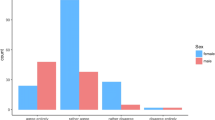Abstract
Anemia remains a significant public health challenge, disproportionately impacting lower-income patients residing in areas of lesser healthcare resources. We sought to evaluate the accuracy of physical exam techniques to diagnose anemia among patients 5 years of age or older. A systematic review of 5 databases (MEDLINE via OVID, EMBASE, Scopus, Global Health and Global Health Archives, and WHO Global Index Medicus) was conducted. Studies that (1) compared non-invasive physical exam techniques with anemia diagnoses using standard laboratory measurements and (2) solely assessed or separately reported the diagnostic accuracy of physical exam techniques for patients 5 years or older were considered for inclusion. The diagnostic accuracies of individual and combinatorial physical exam techniques todiagnose anemia were documented. This systematic review was registered with PROSPERO. The systemic literature search yielded 6,457 unique studies after removal of duplicates. Fourteen studies were ultimately selected for inclusion. Eight studies solely assessed pregnant females, 4 solely assessed hospitalized patients, and 2 evaluated the general population. The diagnostic accuracy ranged widely for pallor assessments of conjunctivae (sensitivity: 19–97%, specificity: 65–100%), nailbed (sensitivity: 41–65%, specificity: 58–93%), and palms (sensitivity: 33–91%, specificity: 54–93%). Examining 9 or more sites leads to higher sensitivity (73.8–82.9%) and specificity (76.0–90.9%). No individual examination technique is superior to others for diagnosing anemia. Combinatorial approachs are associated with more acceptable accuracy measures, but improvements need to be balanced with time available for examination.

Similar content being viewed by others
Code Availability
All necessary data is provided in tables, figures, and supplementary materials.
References
McLean E et al (2009) Worldwide prevalence of anaemia, WHO vitamin and mineral nutrition information system, 1993–2005. Public Health Nutr 12(4):444–454
Scott SP et al (2014) The impact of anemia on child mortality: an updated review. Nutrients 6(12):5915–5932
Black RE et al (2013) Maternal and child undernutrition and overweight in low-income and middle-income countries. Lancet 382(9890):427–451
Nappi J (2003) Anemia in patients with coronary artery disease. Am J Health Syst Pharm 60(14 Suppl 3):S4-8
Morelli V (2017) An introduction to primary care in underserved populations: definitions, scope, and challenges. Prim Care 44(1):1–9
Sengupta A et al (2018) Tackling the primary care access challenge in South Asia. BMJ 363:871
Irving G et al (2017) International variations in primary care physician consultation time: a systematic review of 67 countries. BMJ Open 7(10):e017902
Chalco JP et al (2005) Accuracy of clinical pallor in the diagnosis of anaemia in children: a meta-analysis. BMC Pediatr 5:46
Cleo G et al (2019) Usability and acceptability of four systematic review automation software packages: a mixed method design. Syst Rev 8(1):145
Van den Broek N et al (1999) Diagnosing anaemia in pregnancy in rural clinics: assessing the potential of the haemoglobin colour scale. Bull World Health Organ 77(1):15
Butt Z et al (2010) Diagnostic accuracy of" pallor" for detecting mild and severe anaemia in hospitalized patients JPMA. J Pakistan Med Assoc 60(9):762
Bergsjø P et al (2008) Validity of non-invasive assessment of anaemia in pregnancy. Tropical Med Int Health 13(2):272–277
Bala D et al (2012) Validity and reliability of haemoglobin colour scale and its comparison with clinical signs in diagnosing anaemia in pregnancy in Ahmedabad India. EMHJ-Eastern Mediterranean Health J 18(7):749–754
Chathurani U et al (2012) Anaemia in pregnancy in the district of Anuradhapura, Sri Lanka–need for updating prevalence data and screening strategies. Ceylon Med J 57(3):101
Chowdhury MEEK et al (2002) Taking a medical history and using a colour scale during clinical examination of pallor improves detection of anaemia. Tropical Med Int Health 7(2):133–139
Collings S et al (2016) Non-invasive detection of anaemia using digital photographs of the conjunctiva. PLoS One 11(4):e0153286
Kalantri A et al (2010) Accuracy and reliability of pallor for detecting anaemia: a hospital-based diagnostic accuracy study. PLoS One 5(1):e8545
Nardone DA et al (1990) Usefulness of physical examination in detecting the presence or absence of anemia. Arch Intern Med 150(1):201–204
Sanchez-Carrillo CI (1989) Bias due to conjunctiva hue and the clinical assessment of anemia. J Clin Epidemiol 42(8):751–754
Tan AS, Thaddeus LJ (2009) The use of an anemia scoring index to predict severity of anemia among emergency OB-gyne patients. Philipp J Obstet Gynecol 33(1):10–14
Gies S et al (2003) Comparison of screening methods for anaemia in pregnant women in Awassa Ethiopia. Tropical Med Int Health 8(4):301–309
Wallace DE et al (2000) The influence of experience and specialisation on the reliability of a common clinical sign. Ann R Coll Surg Engl 82(5):336
Shulman C et al (2001) Screening for severe anaemia in pregnancy in Kenya, using pallor examination and self-reported morbidity. Trans R Soc Trop Med Hyg 95(3):250–255
Sheth TN et al (1997) The relation of conjunctival pallor to the presence of anemia. J Gen Intern Med 12(2):102–106
Chiang CP et al (2020) Atrophic glossitis: Etiology, serum autoantibodies, anemia, hematinic deficiencies, hyperhomocysteinemia, and management. J Formos Med Assoc 119(4):774–780
Wu YC et al (2014) Oral manifestations and blood profile in patients with iron deficiency anemia. J Formos Med Assoc 113(2):83–87
Education P Clinical Assessment of Skin Color.
Funding
The authors declare no financial interests.
Author information
Authors and Affiliations
Contributions
The authors confirm contribution to the paper as follows: study conception and design: NV, VV, and SH; data collection: NV and VV; analysis and interpretation of results: NV and VV; draft manuscript preparation: NV, VV, SH, TS, CM, RR, HC, AS. All authors reviewed the results and approved the final version of the manuscript.
Corresponding author
Ethics declarations
Conflict of interest
The authors declare no competing interests.
Ethical Approval
Not applicable for study.
Supplementary Information
Below is the link to the electronic supplementary material.
Rights and permissions
About this article
Cite this article
Vyas, N., Hendren, S., Tushar Sehgal, D.M. et al. The Accuracy of Physical Examination to Diagnose Anemia Among Patients Five Years or Older: A Systematic Review. Indian J Hematol Blood Transfus 39, 90–101 (2023). https://doi.org/10.1007/s12288-022-01543-z
Received:
Accepted:
Published:
Issue Date:
DOI: https://doi.org/10.1007/s12288-022-01543-z




